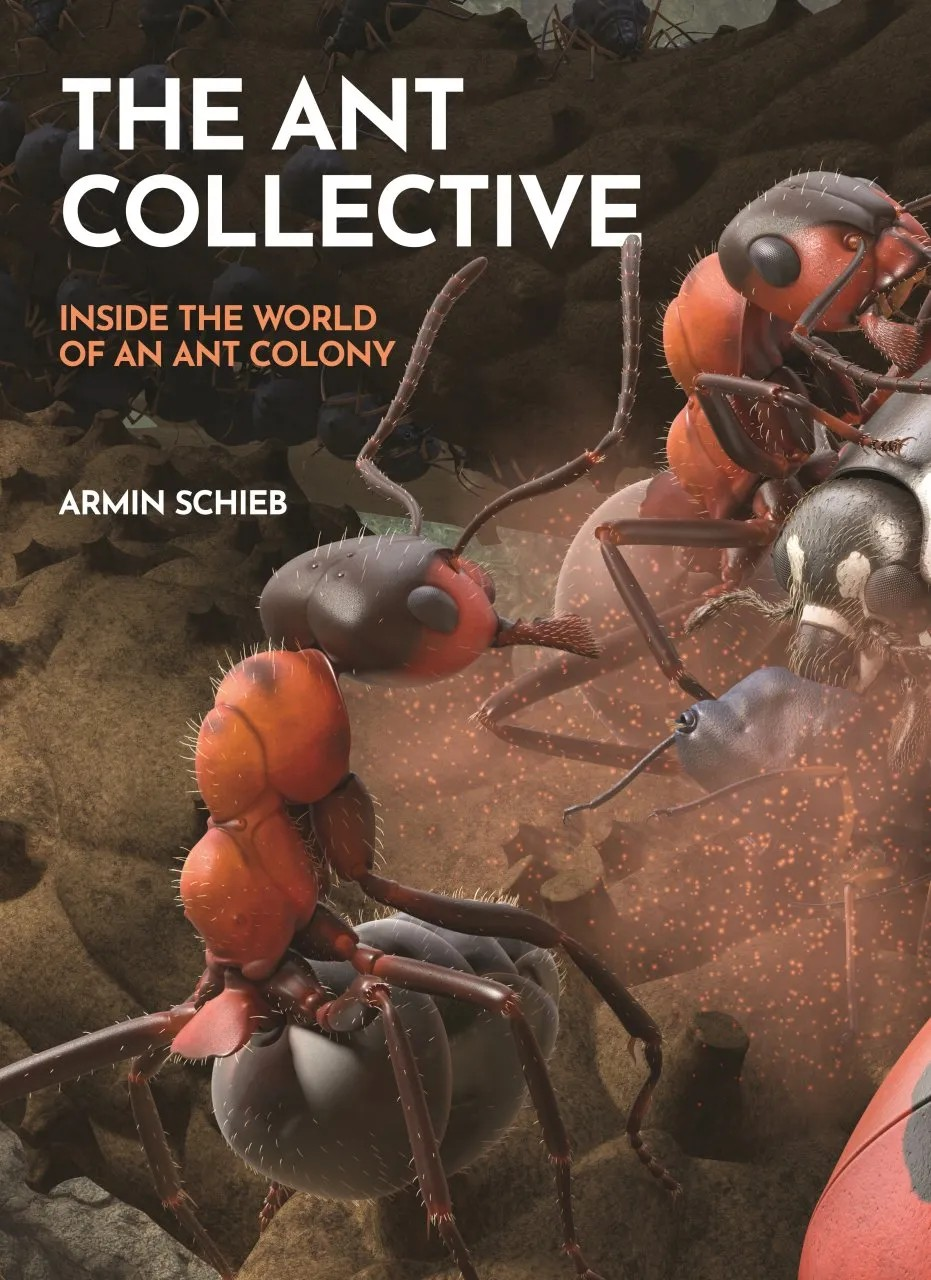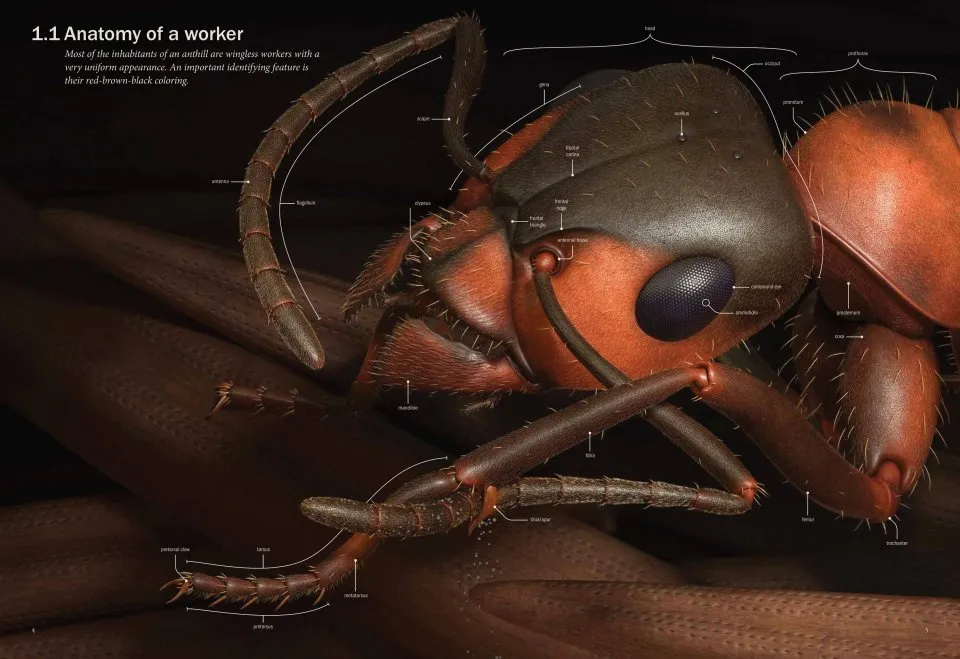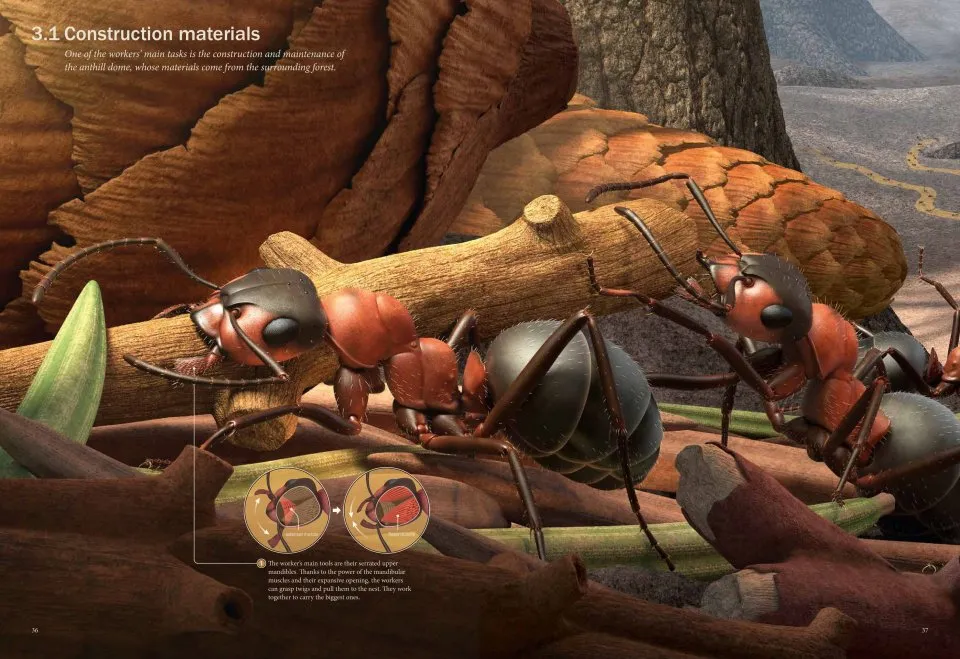 ***** A wonderful graphical introduction to the inner workings of an ant colony
***** A wonderful graphical introduction to the inner workings of an ant colony
This one grabbed my attention as soon as it was announced. Not a comic or graphic novel, but an A4-format book about ant colonies that is chock-a-block with infographics? Yes, please! Showcasing the best of what science illustration can be and combining it with a genuine outsider’s interest in entomology, The Ant Collective makes for a wonderful graphical introduction that will appeal to a very broad audience of all ages.
This book was originally published in German in 2022 as Das Ameisenkollektiv by Kosmos Verlag. It was quickly snapped up for translation into French and Spanish before Princeton University Press published it in English in 2024, courtesy of translator Alexandra Bird. Armin Schieb is a freelance science illustrator based in Hamburg, Germany, and this book is derived from his master’s thesis in Informative Illustration at the Hamburg University of Applied Sciences. His portfolio shows infographics, 3D models, and cover illustrations for a range of clients, from magazines to newspapers to publishers, but this book represents his first published work to date.
Based on direct observations, sketches, and photos of red wood ants (Formica rufa), Schieb has designed 61 highly detailed computer-generated illustrations showing ants from a bug’s eye perspective that entomologists can only dream of. The eight chapters each contain a mixture of full-page spreads with naturalistic 3D renderings of landscapes full of ants, and pages with numerous smaller infographics that explain how colonies function. Annotations are scattered throughout to provide context to what you are looking at. Neatly, many of the full-page spreads continue overleaf, forming eight-page tableaux. One can only imagine what they would have looked like if the publisher had included them as gatefolds!
Next to obligatory drawings introducing ant anatomy, the focus of this book is on colony-level behaviour, with chapters depicting nuptial flights, nest establishment and construction, seasonal cycles of nest maintenance, foraging, trail formation, food acquisition and defence, reproduction, nest defence, and the formation of new colonies. The clever use of cutaway illustrations reveals processes that normally play out unseen underground.

There are some memorable scenes in here showing e.g. green woodpeckers and boars raiding ant nests. The woodpecker illustration stands out in particular. Red wood ants defend themselves by spraying formic acid and are normally inedible. The birds, though, have turned the tables on the ants twice over, picking them up in their beak and rubbing them on their feathers where the ants discharge the contents of their poison glands. As an added bonus, the formic acid repels feather parasites. This whole story is illustrated by overlaying several semitransparent motion frames of a woodpecker twisting its head and is glorious to behold. Elsewhere, Schieb uses motion blur to good effect to highlight the action-packed nature of spiders and antlions catching hapless ants.
Needless to say, this book is full of fascinating titbits of information. Schieb explains the phenomenon of age polyethism that I first encountered in Ant Architecture. Young ants tend to stay inside or close to the nest, while older ants venture further out to do the dangerous job of foraging (though Ant Encounters for some criticism of this idea). Schieb (perhaps unwittingly) offers an excellent illustration of colony behaviour arising through interaction networks when he shows how foraging trails wax and wane as a function of behavioural interactions between ants. There is similarly a deft explanation of the anatomical details of the eyes that allow them to see both polarized and unpolarized light: straight or spiralling stacks of light-sensitive tubules. It is one of those concepts where a picture says more than a thousand words. The only criticism I have of this particular section is that I would have opened it with the otherwise excellent illustration explaining sky polarization. Additionally, I would have added an infographic that explains what polarized light actually is, as it is a surprisingly tricky phenomenon to explain. Michael Land’s book Eyes to See contains a good picture, whereas Schieb basically takes it as a given that readers will understand what he means when writing that “almost all photons in a polarized light ray vibrate in the same plane” (p. 64).
 The promotional blurb for the book mentions it draws on the latest science though I was left somewhat confused when I finished it. Schieb is obviously not an entomologist but a graphic artist. There is no mention of the project having benefited from one or several entomologists acting as consultants to give the contents the once-over for scientific accuracy. There is no acknowledgements section where Schieb credits scientists for advice and input. There is not even a list of references or recommended reading included. Or is there? Since I do not have access to the German original I had to resort to some online sleuthing and found a preview on Amazon.de that includes the reference list on p. 126. This reveals that, yes, he has consulted books and scientific papers in both English and German, including that evergreen The Ants, an older edition of Insect Physiology and Biochemistry, and both specialist and general German books on forest insects. So, Schieb did his homework, Kosmos referenced it, but for some bizarre reason, Princeton simply omitted it, as the page between 125 and 127 is… blank! Did I just happen to receive a dud to review? Checking eight other copies at our warehouse confirmed that, no, this is a feature, not a bug. Hopefully, if there are future print runs, this is a detail that can be rectified, as it could easily leave readers with the wrong impression.
The promotional blurb for the book mentions it draws on the latest science though I was left somewhat confused when I finished it. Schieb is obviously not an entomologist but a graphic artist. There is no mention of the project having benefited from one or several entomologists acting as consultants to give the contents the once-over for scientific accuracy. There is no acknowledgements section where Schieb credits scientists for advice and input. There is not even a list of references or recommended reading included. Or is there? Since I do not have access to the German original I had to resort to some online sleuthing and found a preview on Amazon.de that includes the reference list on p. 126. This reveals that, yes, he has consulted books and scientific papers in both English and German, including that evergreen The Ants, an older edition of Insect Physiology and Biochemistry, and both specialist and general German books on forest insects. So, Schieb did his homework, Kosmos referenced it, but for some bizarre reason, Princeton simply omitted it, as the page between 125 and 127 is… blank! Did I just happen to receive a dud to review? Checking eight other copies at our warehouse confirmed that, no, this is a feature, not a bug. Hopefully, if there are future print runs, this is a detail that can be rectified, as it could easily leave readers with the wrong impression.
Over the years, I have reviewed some seriously impressive photographic books on ants, covering amongst others army ants, desert ants, and myrmecophiles. Despite being a slimmer volume written for a general audience, The Ant Collective rubs shoulders with the greats where visual content is concerned. This is a feast for the eyes that will lure newcomers into entomology but should also please seasoned myrmecologists.
A final thing to note is that this book tells the biology of a *single* species. Wood ants are well-studied as far as ants go, but as the subtitle indicates, this is a look inside the world of *a* ant colony. It would be a mistake to come away from this book thinking that this is how colonies of all ant species function. The world of ants is one of bewildering diversity, though themes and unifying principles are starting to emerge.
The Ant Collective is available from our online bookstore.
